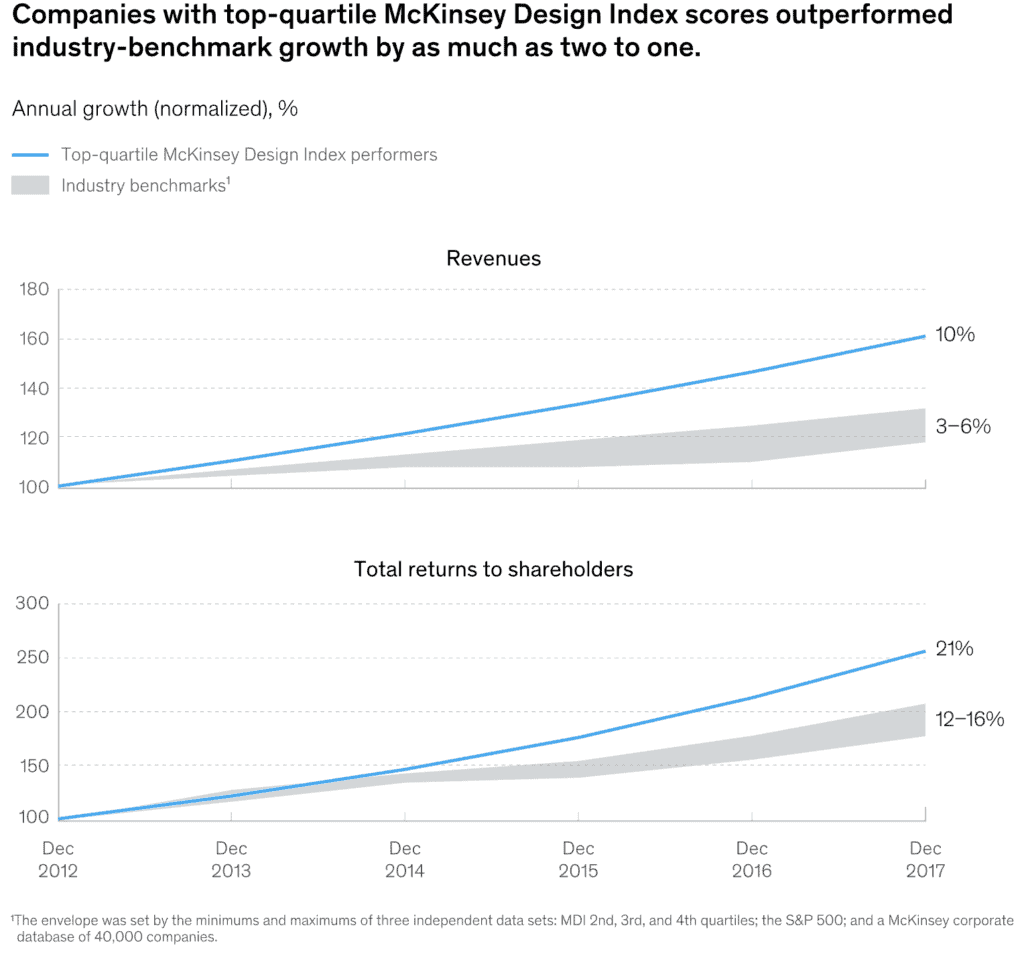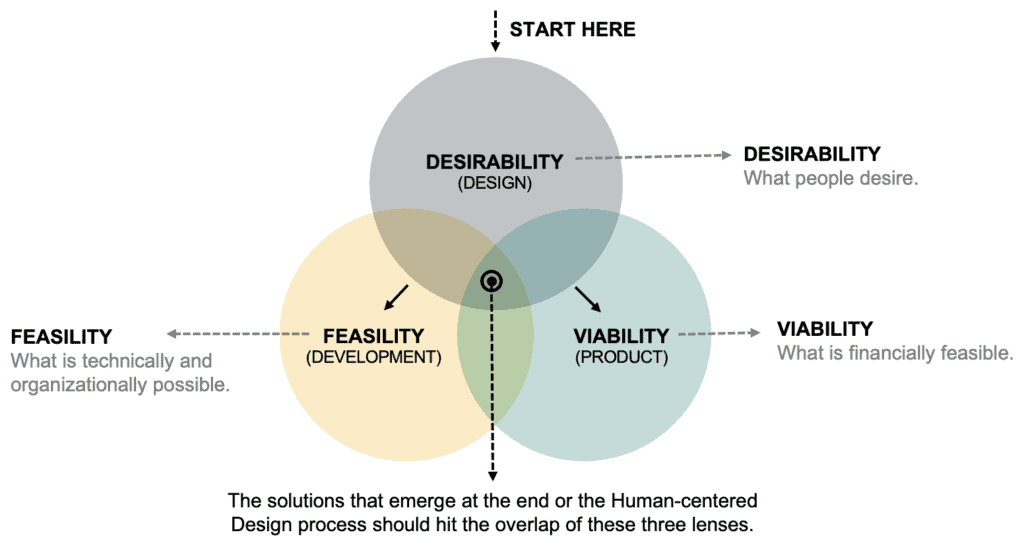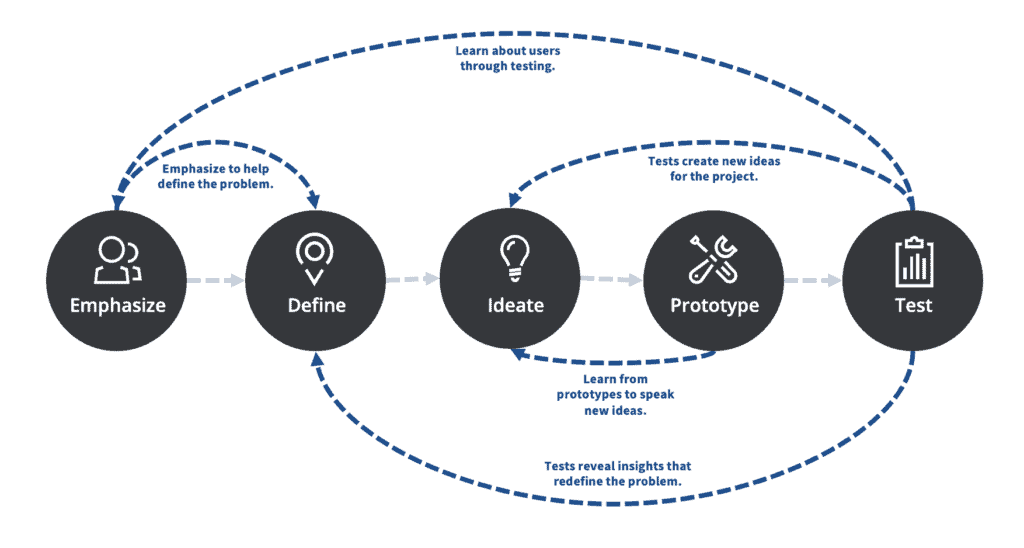Companies (large or small) are rapidly learning that in order to yield the greatest financial returns it is best to combine design and business leadership through a design-centric vision. A report by McKinsey & Company tracked the design practices of 300 publicly listed companies over a five-year period in multiple countries and industries.

Innovative companies have curiosity at the leadership level about what users need, as opposed to what they say they want.
To achieve great design, it is imperative to develop from the point of view of the customer. This approach ensures that the final product will be designed to capture not only the highest amount of consumers, but also ensure your product is targeting the right consumer. To achieve these results, design needs to be an integral piece of planning from the start.
Often times, design is overlooked and addressed in the 11th hour to make the final product “look pretty.” This overlooks the fundamental question presented to every organization: do we truly understand what our customer is seeking? Not having a strong answer to this question at the onset of any project often leads to multiple redesigns, lost hours of work, and busted budgets. Most projects start with a focus on the viability (business) and feasibility (development/engineering) of the assignment. Does it make economic sense, and do we have the ability to deliver the product? While these are integral questions to any project and must be addressed, focusing on these two portions often come at the expense of considering the desirability (design) of the end-product. Also incorporating and focusing on desirability at the start, you ensure that a customer’s true concerns are taken into consideration and never overlooked while weighing out the viability and feasibility of a project. This approach at the start of the project will ensure your team makes informed, strategic decisions that will save invaluable time and money.

Design Thinking — the innovative practice used by small, family-owned businesses and Fortune 100 companies such as Google and Apple alike — seeks to help companies avoid this common mistake of waiting until the end of a project to incorporate design. Instead, design of the product or service, drives the entirety of the project by serving as the overarching element that guides each step of the creation process.
What is Design Thinking?
Design thinking is a non-linear, iterative process that teams use to understand users, challenge assumptions, redefine problems and create innovative solutions to tackling problems that are ill-defined or unknown. It is a human-centered approach to design and innovation. In short, the goal is to ensure that the focus remains on the customer and addressing their unique needs. Through empathetic problem solving, your team will never lose sight of addressing the human needs of the consumer and refrain from focusing on solely meeting an analytically driven result.
Phases of Design Thinking

These five non-linear steps are designed to allow the project team to jump in and out of each phase as the project dictates. While each of these phases has defined steps within, the project team maintains the ability to move in and out of each phase seamlessly.
Empathize
Empathize is considered the starting phase when applying Design Thinking. Here is where you remove any and all assumptions you might have regarding the needs of the customer and instead gather information in order to best understand their unique needs. In my experience using Design Thinking for my clients, I have found it best to document all internal assumptions and then conduct research to get a grasp of the client’s specific needs. Research can include reviewing quantitative data that has been collected through surveys and analytical platforms, or qualitative data sources, such as user interviews and observations
Define
Once you feel sufficient research has been conducted during the Empathize phase and you feel comfortable that you have a strong understanding of the issues presenting your customer, it is time to synthesize your finding and define the core problems that have been identified. This definition is referred to as the “problem statement”. Your definition should represent a meaningful and actionable problem statement that will provide focus for your team throughout the remaining steps.
An important note for this phase: I find this phase to be the most challenging for my clients to achieve. Success in this phase requires that your team successfully completed the Empathize phase and gained a full understanding of the client’s needs. Developing a strong problem statement during the Define phase will guide you and your team’s work by providing clarity and will serve as an excellent catalyst for the next phase.
Ideate
At this stage, you’re set to introduce some creativity to the project. Instead of resorting on the first or second idea that may come to mind in order to solve a customer’s issue, take the extra time to involve a wide range of coworkers from across the company and conduct creative brainstorming sessions. In these sessions, there are no bad ideas. By introducing ideas from coworkers that are outside the project and possess unbiased opinions you increase the opportunities to inspire additional ideas.
Once you’ve pared down your list of ideas to the one that is most desirable, viable and feasible you are ready to develop a prototype solution.
Prototype
This is an experimental phase — it’s important to keep in mind that what you create here isn’t meant to lock you into a specific plan. Your goal here is to take the idea you agreed upon during the Ideate phase and put its desirability to the test. You are hoping to identify and demonstrate that the idea you agreed upon is in fact the best solution possible for your customer.
To do this, your team should create an inexpensive and scaled down version of the product. Prior to even entering the Test phase, this prototype will afford you the opportunity to identify any obvious issues and address them before you move forward.
Test
Now it’s time to put your unique and innovative idea to the test, but this doesn’t mean it’s final! This is your opportunity to redefine your idea, as needed, to ensure what you’re presenting to the customer does in fact meet all their needs. In this phase you’ll involve your customer directly. Gather feedback from the customer and rework your idea as necessary to reflect their comments. The purpose of the test is to validate every decision and assumption that was made up to this point, not just how the solution looks.
Remember: User feedback is priceless! Without an understanding of what users need in order to carry out specific activities and tasks, you will not be able to deliver a successful product to the customer.
Start with Design Thinking
Applying Design Thinking to your project management process at the start of your project will help you cut down on burdensome (and costly) redesigns and iterations. Further, it will help quickly get in sync with your customer at the onset, ensuring them that you’re empathetic to their needs and are working to develop a solution that is uniquely designed for them.
Each time you apply Design Thinking you are opening yourself up to new insights to help inform your understanding of the customer’s needs. This deeper understanding helps you develop a problem statement that will set a clear path for your team to follow throughout the project’s lifecycle. Having a clearly defined goal also gives your team the time to get creative and work on innovative solutions that can be developed as a prototype and tested with consumers.
Most importantly, this process isn’t linear or rigid. Your project team will be able to enter into any phase necessary at any time without having to restart the entire process, an invaluable benefit to any product management effort, as the needs of a customer can often change from one day to the next. The flexibility of Design Thinking and the inclusion of the intended consumer is what helps set this process apart from traditional methods. It provides a quick and accurate method that delivers targeted value to your customer in a cost effective manner.


